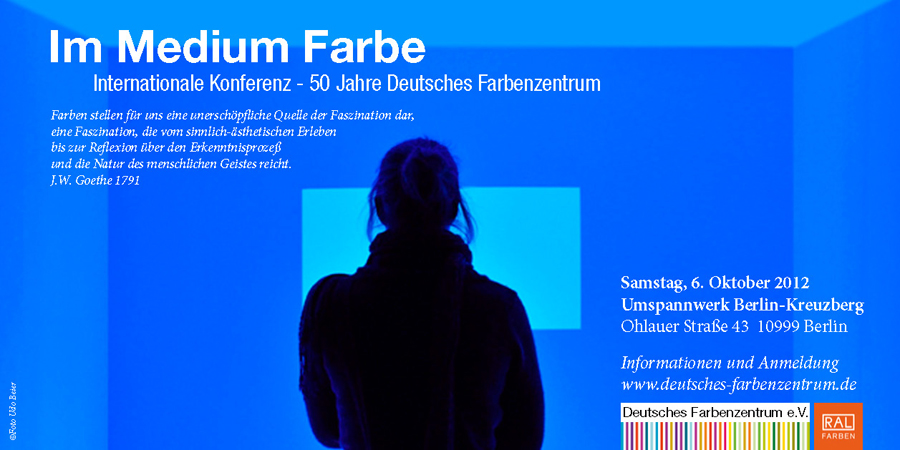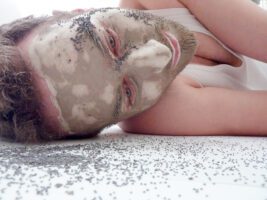
With this year’s international conference “In the Medium of Color”, we would like to draw a wide arc from the beginnings to the present of the “Deutsches Farbenzentrum e.V.”. The founder Kurt Görsdorf was prompted by the realization that everything described by the word color can only be understood as an interdisciplinary phenomenon. The German Color Center has thus been committed to promoting interdisciplinary work in all areas of color knowledge and activity for half a century.
“Colors are an inexhaustible source of fascination for us, a fascination that ranges from sensual-aesthetic experience to reflection on the process of cognition and the nature of the human spirit.”
J.W. Goethe 1791
Lecture program:
Saturday from 9:00 a.m. Registration and handing out of conference documents
9:30 Welcome and introduction
Prof. Dr. Axel Buether & Dr. Anne-Marie Neser
Conference organization and board DFZ
Color in art and science
10:00 Prof. Klaus Palm & Prof. Klaus Richter
Honorary Chairwoman DFZ: Color in art, design, technology and science – 50 years DFZ and 48 years exhibition color and color vision.
Abstract: As a representative of the wholeness of our being, color is a unique example of the equal coexistence of the fundamentals: natural sciences, humanities, art and design. In 1962, this insight was cast in an interdisciplinary, binding legal form with the founding of the German Color Center as the “Central Institute for Color in Science and Design”. In addition to interdisciplinary information and personal contacts, the importance of color and the interplay between all disciplines has been successfully practiced for half a century at the annual color congresses and the numerous in-depth events, the Phänomena seminars. A big thank you goes to everyone who has contributed to keeping the phenomenon of color alive as an integral part of our culture over these 50 years.
Color between aesthetics and aisthesis
Prof. Dr. Christoph Wagner
Art History at the University of Regensburg, spokesman for the thematic network Seeing and Understanding at the University of Regensburg, President of the Society for Interdisciplinary Visual Studies, research interests: Painting and art theory of the modern era and modernism; Italian art and visual culture of the 20th century 15. and 16th century; historiography and art theory of classical modernism; painting after 1945; political iconography; history of perception; methodology of art history; relationship between art and the natural sciences.
Abstract: The fact that the history of color is able to depict “as naturally, the history of the human spirit in miniature” is one of the precious marginal notes that Goethe passed on in his reflections on color. After the significant shake-up caused by scientific brain research, we now recognize more than ever that the “subjective” quality of color, which has long been reviled, reflects nothing other than the subjective qualities of the human mind in a special way, indeed that perhaps no other area is better suited to introducing us to the subjective structures of human perception and interpretation of the world around us than the observation of color.
Color in music
Neil Harbisson
Sonochromatic Cyborg, Barcelona Spain: British-Catalan cyborg artist, musician and performer best known for his self-extended ability to hear colors. In 2004 he became the first person in the world to be fitted with an eyeborg and to be officially recognized as a cyborg by a government. Color and the use of technology as an extension of the performer’s body and senses are the central themes in Harbisson’s work.
Abstract: Neil Harbisson will talk about his grey scale visual condition (achromatopsia) and how his life has changed since he attached an electronic eye to his head in order to hear colors. He will talk about the close relationship between color and sound, about his new visual condition (sonochromatopsia) and about his latest artistic works.
Color in film
Prof. Dr. Susanne Marschall
Media scientist (focus: audiovisual media, film and television), University of Tübingen Research field: Color in cinema: We perceive color in the cinema with all our senses. It triggers emotions and meets expectations. The author goes in search of the foundations of a color theory of cinematic art. Findings from perceptual psychology, music psychology and synaesthesia research on the interplay of color and sound, physics, color chemistry, optics, cultural studies, linguistics, anthroplogy and art history are incorporated into the study.
Abstract: The lecture “Color in Cinema” picks out the technically and aesthetically productive and innovative first phase of the development history of color cinema up to the high-quality Technicolor films of the 1950s from the variety of possible aspects of this broad subject area. Based on an examination of the perceptual psychological characteristics of human color perception and the gradual development of color dramaturgical rules and expressive rule-breaking in cinema, the lecture opens up new perspectives on the history of color film. Exemplary films accompany this threefold, i.e. perceptual-psychological, historical and aesthetic interpretation of the cinematic experience in color, which for the most part did not move within the narrow confines of representational realism, but – quite comparable to painting – drew on the full range of creative possibilities with light and color.
Color in the natural sciences
Prof. Dr. Armin Reller
Prof. Dr. Armin Reller, born 1952 in Winterthur, studied chemistry at the University of Zurich. He was the coordinator of environmental studies there from 1988-1992. In 1992 he took over the Chair of Inorganic and Applied Chemistry at the University of Hamburg, in 1999 the Chair of Solid State Chemistry at the University of Augsburg and has held the Chair of Resource Strategy at the University of Augsburg since 2009. Prof. Reller is spokesman of the board of the Environmental Science Center.
Color in urban space
Michel CLER
, Architecte DESA, Consultant Couleur
France CLER, Peintre, Ecole Beaux-Arts Aix en Provence et Marseille, Consultant Couleur
Verena M. Schindler
, Historienne de l’art et de l’architecture, Study Group on Environmental Colour Design (ECD) of the International Colour Association (AIC)
Research Chromatictownscapes – Atmospheres of Chromaticscapes: In long-term processes “colour” (coloured appearance) and material function as components to inform (memory, management), to plan spaces, for individuals and groups to identify in different contexts as well as their activities.
Color in bodily communication
Prof. Dr. Hermann Schmitz
Philosopher, University of Kiel (emer.): The New Phenomenology owes its conceptual and thematic foundation to the philosophical efforts of Hermann Schmitz. With patient care, he has made the unbiased experience of life accessible to accountable speech on a broad front and thus – based on what we feel in our own bodies – opened up large areas of reality to methodical reflection: Body, feelings, atmospheres, situations.
Abstract: Based on the contrast between the historicity (timelessness) of sound and the timelessness of color, the different receptivity of sound and color for bodily communication in the media of motion suggestion and synesthetic characters is discussed. The synaesthetic characters of the colors are touched on with reference to Goethe. The absence of the suggestion of movement in the colors is attributed to their tendency towards surfaces foreign to the body; in connection with this, the difference between spaces with and without surfaces (close to the body) is touched upon. In contrast to the surface colors, the pre-dimensional colors (misleadingly called “surface colors”) are close to the body.
Color as a medium – Karl Miescher Prize Winner 2012 – Design
Raw Color – Daniera ter Haar & Christoph Brach
Graphic design & photography, Eindhoven (Netherlands): The work of Raw Color reflects a sophisticated treatment of material and color by mixing the fields of graphic design and photography. This is embodied through research and experiments, building their visual language. Daniera ter Haar & Christoph Brach work on self initiated and commissioned projects in their Eindhoven based studio.
Abstract: Driven by curiosity Raw Color is questioning the meaning of the subject they are working on. Within these aspects the materialization of colour plays a key role, and can be seen as the core of the studio. It is a medium that allows them to travel across the disciplines. By experimenting and trusting on their intuition Raw Color has created a design language that is verbally direct, energetic and recognizable. During their talk they will take you on a trip to experience color in different media and projects.
Color in the material – Karl Miescher Prize winner 2012 – Knowledge
Stefan Muntwyler
Painter and color researcher “I have become insatiable in my color kitchen. I haven’t painted pictures in the classical sense for a long time. I paint colors. Painting has become a culinary delight.”
Abstract: COLOR YELLOW: SAFRAN, URIN and ARSEN Author of the standard work COLOR PIGMENTS COLOR MATERIALS COLOR HISTORIES, will tell exciting stories about the color yellow as a painter with large-scale color panels created especially for this event. Not just a presentation, but a small spectacle full of surprises and secrets that are revealed. Muntwyler traces an arc from the historical yellow pigments to the present day.
Evening event
+++ Celebration of 50 years of DFZ with activities by members, guests and students
– Photographic traces from 50 years of DFZ – Prof. Klaus Palm
– Statements by members and guests as contemporary witnesses of the history of the DFZ – Prof. Hans K. Schlegel, Gerd Schilling, Josep Linschinger, Hajo Düchting, Lothar Gericke, Charlotte Kollmorgen, Gisela Braune, Eckhard Bendin, Martin Benad, Dr. Eva Lübbe, Prof. Dr. M. Schaum, Klaus v. Saalfeld, Prof. Axel Venn, Susanne Wied et al.
+++ “Ask me about Color!”,
Action by students of the HAWK Hildesheim (headed by Prof. Timo Rieke)
Poster lecture “Retouching fluorescent colors”
+++ Color-space-sound light installation
Gisela-Meyer Hahn and Sonny Thet
+++ On Friday, October 5, between 7 and 8 p.m. (2 guided tours of 30 minutes each), you can visit the TU exhibition “Color, Color Vision and Applications” at . Meeting point: Department of Lighting Technology, TU Berlin, 10587 Berlin, Einsteinufer 19, entrance Pfoertner Gebaeude E-N (in the middle between the electrical engineering institutes, old building (E) and new building (E-N)), room E-N 055
Address Conference and anniversary celebration:
Kreuzberg substation
Ohlauer Street 43 D-10999 Berlin
Information and fax registration form
(Return by fax 030 61076293 or mail to vorstand@deutsches-farbenzentrum.de)
+++ Telephone information or tel. Registration under 030 61076398 (H. Krauss)
Main sponsor RAL gemeinnützige GmbH
The company supports participation in the conference for students and trainees
More information and registration >> Externer Link Deutsches Farbenzentrum e.V.


